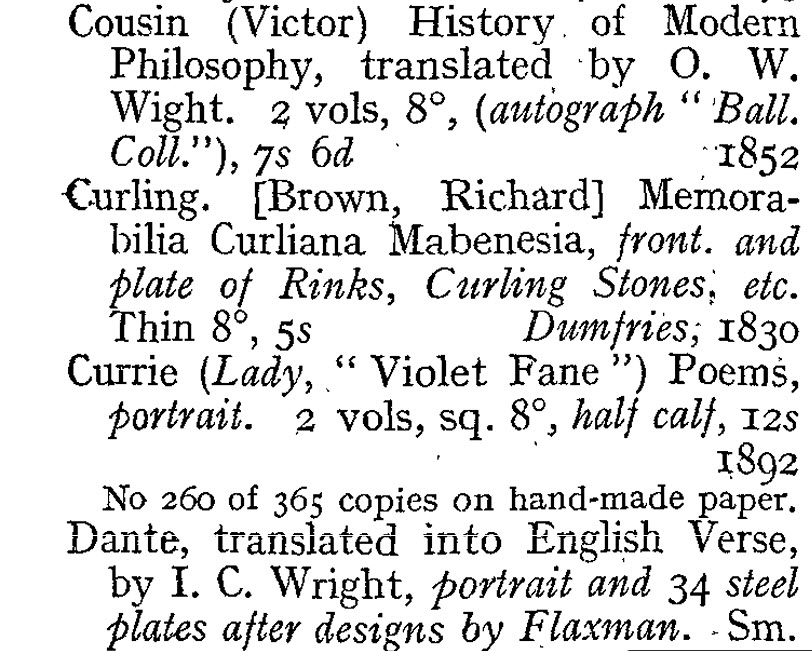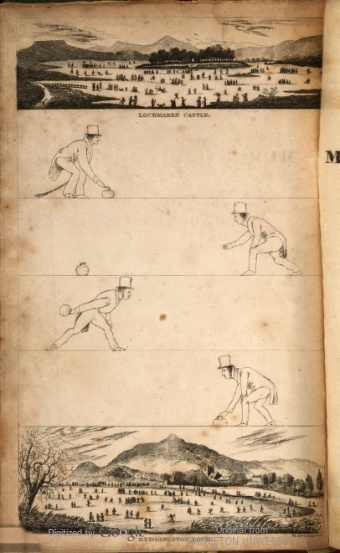Our lab’s task of re-creating John Addington Symonds’ library has most recently taken us to the catalogue of its contents prepared by William George’s Sons, a prominent bookseller in Bristol.1 Although the catalogue is from 1909, 16 years after Symonds’ death, it can shed much light on the influences and inspirations for his scholarly works. Additionally, the contents listed in the 1909 catalogue can give us information about Symonds beyond our understanding of him as an academic. Symonds was a prolific historian and classicist, who made significant contributions to queer history and literature, being one of the first people to use the term “homosexuality” in A Problem in Modern Ethics. In this essay and its predecessor, A Problem in Greek Ethics, he gives insight into classical history and provides a working understanding of Ancient Greek sexual culture.
In academic study it is often common to view important figures only within the context of their scholarly or literary output. Rarely have I been asked to think about an author beyond the scope of reading and analyzing their literature. Our work on Symonds has felt like fresh air, seeing him not only for his work and but also beyond it, learning about him in intimate detail through his memoirs and letters he wrote. Given the breadth of Symonds’ work, it has been fascinating to read through the catalogue of his library and see the direct influences on his writing. Between books on poetry, philosophy, language, and art, one can see the amount of literature at his disposal. In analyzing this catalogue, clear connections can be made from the contents of his library to his own written works, allowing us to trace his inspirations in a remarkable way.
And yet, not every connection is so clear. The book that struck me most, for instance, was Richard Brown’s Memorabilia Curliana Mabenensia, and Symonds’ copy was likely the first edition published in 1830.2 It was somewhat hard to find information on the book due to a typo in the catalogue, but I was able to dig around and find an electronic copy through the HathiTrust Digital Library. Not recognizing the Latin vocabulary in the title, I was surprised to discover it is a book on the history of curling. Different sections of the book outline the rules, strategies, lingo, and history of the winter sport, particularly referencing Scottish curlers of the Lochmaben Curling Society. Considering the impressive and intellectual makeup of his library, I found the presence of the Memorabilia puzzling; within a library largely comprised of works seemingly related to Symonds’ scholarly pursuits, where on Earth do Scottish curlers fit? What is their place among Homer, Thucydides, and Shelley, to name a mere few? We know from Symonds’ Memoirs that he did not care for sports in his youth, and yet he owned a book on curling.

Screenshot from Books on poetry, art, biography, etc., from the library of late John Addington Symonds, removed from Am Hof, Davos Platz, Switzerland. Offered for sale by William George’s Sons. Bristol, 1909.
After a few moments of perplexed reflection, I thought about how reductive that line of thinking was. Though we know Symonds largely for his notable academic work, it is foolish to expect that his interests were limited to those efforts alone. Why should I think his interests could not evolve? There are many things I detested in youth that I can now enjoy even just in young adulthood (e.g. tomatoes, running). Likewise, I’m sure we can all relate to a few seemingly “out of character” pieces of literature, art, or music in our various collections. As evidence of pursuits outside of academia, the Memorabilia serves to show the diversity and range of his interests, reminding us of his humanity.
Though unrelated to the academic interests for which he was known, it is possible to establish connections with his works describing his life in Switzerland. In Our Life in the Swiss Highlands (which he wrote with his daughter shortly before his death), he dedicates an entire chapter to discussing Swiss athletic sports. 3, 4 Sporting events in the winter season appear to have been an important means of integrating into Swiss culture and meeting people, and specifically, young men. Here we can start connecting the dots. Curling, among other athletic sports, likely served as a way for Symonds connect to the communities around him in Switzerland in the last years of his life. The Memorabilia seems to be the only book in the catalogue that focuses on sports, yet it gives us a peek into Symonds’ Swiss life and shows us more about Symonds as a multi-faceted person and not just a lofty academic. There is something remarkably down-to-earth about engaging in interests in order to make social connections, and to see cute boys exercise.
Exploring the contents of Symonds’ library allows us to appreciate the inspirations behind his extensive academic accomplishments, as well as the influences on his life outside academia. From this we can gain greater insights into who John Addington Symonds was as an author and person, strengthening the lab’s work.
Featured image: Frontispiece for Richard Brown, Memorabilia Curliana Magenensia. Dumfries: J. Sinclair, 1830. Via HathiTrust.
- Books on poetry, art, biography, etc., from the library of late John Addington Symonds, removed from Am Hof, Davos Platz, Switzerland : each work. (1909) Bristol [Gloucestershire] : Offered for sale by William George’s Sons.
- Brown, R. (1830). Memorabilia curliana mabenensia. Dumfries: J. Sinclair.
- Symonds, J. Addington. (1879). Sketches and studies in Italy. London: Smith, Elder.
- Symonds, J. Addington., Symonds, M. (1892). Our life in the Swiss highlands. London: A. and C. Black.



